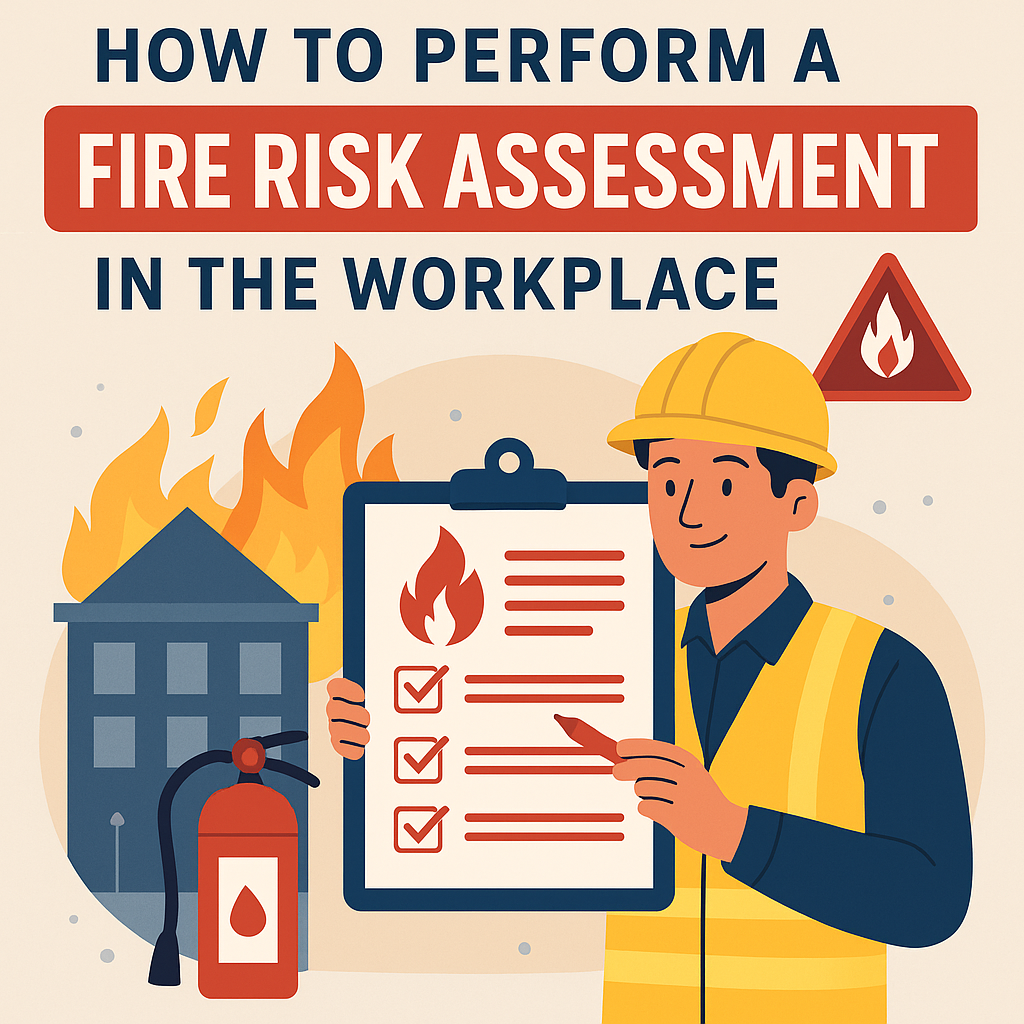
How to Perform a Fire Risk Assessment in the Workplace – Step-by-Step Guide
🔍 Introduction: Why Fire Risk Assessment Matters
Fire hazards are one of the most common and devastating threats in any workplace. From electrical failures to flammable materials, the risk of fire can lead to injury, death, and significant financial loss. That’s why every organization must conduct a Fire Risk Assessment—a legal and moral obligation to protect employees, property, and operations.
This article provides a complete guide on how to perform a fire risk assessment in the workplace, including legal requirements, a 5-step process, sample checklist, risk matrix, and practical tools.
📋 What is a Fire Risk Assessment?
A Fire Risk Assessment (FRA) is a systematic evaluation of fire hazards in a workplace, identifying people at risk, and determining the adequacy of existing fire safety measures. It helps you decide what improvements are necessary to reduce or eliminate risks.
⚖️ Legal Requirements (India, UK, US Overview)
| Country | Legal Framework | Requirements |
|---|---|---|
| India | Factories Act, 1948 & National Building Code (NBC) | Section 38 outlines fire safety responsibilities for employers |
| UK | Regulatory Reform (Fire Safety) Order 2005 | Fire risk assessment is legally required for all non-domestic premises |
| USA | OSHA Standard 29 CFR 1910.39 | Requires written fire prevention plans and risk control |
🔑 5 Steps to Perform a Fire Risk Assessment in the Workplace
✅ Step 1: Identify Fire Hazards
Ask yourself:
- What could start a fire? (heat sources, open flames, faulty wiring)
- What materials could burn? (paper, fuel, chemicals)
- Where are these hazards located?
Examples:
- Loose electrical cables in a storeroom
- Gas cylinders in a poorly ventilated area
- Paper files stored next to heaters
✅ Step 2: Identify People at Risk
Evaluate who may be affected:
- Employees working alone or night shifts
- Visitors and contractors
- Persons with disabilities or mobility issues
Use layout maps or zone analysis to identify high-occupancy or high-risk areas (e.g., server rooms, kitchens).
✅ Step 3: Evaluate Risks & Implement Control Measures
Use a Risk Matrix (see below) to assign severity and likelihood.
Decide whether existing controls are sufficient or if improvements are needed.
Examples of Controls:
- Fire alarms & extinguishers
- Fire doors and safe exits
- Training and fire drills
- Regular inspection & maintenance
✅ Step 4: Record, Plan, and Train
If your organization employs 5 or more people, you must document your findings.
Include:
- Identified hazards
- Who’s at risk
- Measures taken
- Emergency procedures
- Fire safety roles (fire wardens, etc.)
Fire Safety Training should be provided at induction and repeated regularly.
✅ Step 5: Review and Update Regularly
Fire risks can change due to:
- Layout modifications
- New equipment or processes
- Staff turnover
Set a review frequency (e.g., annually) and whenever significant changes occur.
📊 Fire Risk Matrix Example
| Severity | Likelihood | Risk Level |
|---|---|---|
| Major Injury/Death | Likely | High |
| Minor Injury | Possible | Medium |
| Property Damage Only | Unlikely | Low |
Action Plan:
- High: Immediate action required
- Medium: Address in short term
- Low: Monitor and review
✅ Sample Fire Risk Assessment Checklist
| Item | Yes | No | Action Required |
|---|---|---|---|
| Are fire exits clearly marked and accessible? | ✅ | ❌ | Repair exit signs |
| Are extinguishers serviced annually? | ✅ | ❌ | Call maintenance vendor |
| Is fire alarm system tested weekly? | ❌ | ✅ | Assign to maintenance team |
| Are employees trained in fire safety? | ✅ | ❌ | Schedule refresher training |
💡 Tips for Effective Fire Risk Assessment
- Involve multiple departments: HR, Engineering, Safety
- Use visual tools (e.g., evacuation maps)
- Create fire safety zones in the workplace
- Label all high-risk areas
- Conduct unannounced mock drills
🔄 Internal Linking Suggestions
Include internal links to boost SEO and site structure:
- 🔗 How to Conduct a Dynamic Risk Assessment in Real-Time Work Environments
- 🔗 Step-by-Step Guide to Conducting a Job Safety Analysis (JSA) in the Workplace
- 🔗 Electrical Safety Inspection Checklist | Free Downloadable Template
- 🔗 Monthly Office Safety Inspection Checklist | Free Download Template
- 🔗 Free Hot Work Permit Template for Fire Risk Control | Download Now
🌐 External Resources
❓ Frequently Asked Questions (FAQ)
Q1. Who is responsible for fire risk assessment in the workplace?
Answer: The employer or designated safety officer is responsible for ensuring that a fire risk assessment is conducted and reviewed.
Q2. How often should a fire risk assessment be reviewed?
Answer: At least once a year or whenever there are significant changes in layout, equipment, or processes.
Q3. Do I need to hire a professional fire safety consultant?
Answer: For large or high-risk facilities, it’s recommended. Small businesses can often conduct assessments in-house using standardized templates.
Q4. What should I include in a fire emergency plan?
Answer: Evacuation procedures, fire warden roles, assembly points, contact numbers, and training records.
Q5. Is training mandatory for all employees?
Answer: Yes, fire safety training must be provided to all employees at the time of joining and refreshed regularly.
📝 Conclusion
Performing a Fire Risk Assessment is not just a regulatory requirement—it’s a core responsibility for ensuring the safety of your people, assets, and reputation. Following the 5-step framework—identify, evaluate, control, record, and review—helps you stay compliant, prepared, and protected.




















